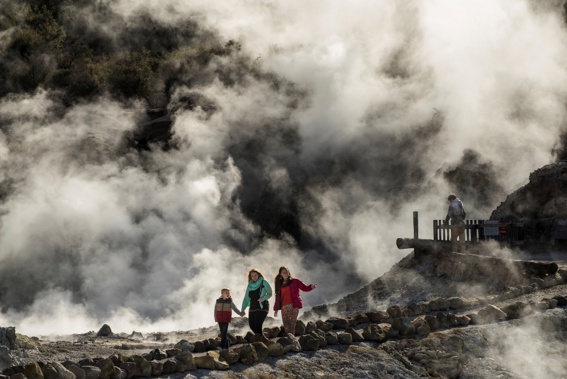
Few New Zealand destinations offer such a therapeutic, embracing antidote to winter’s bracing chill quite like the geothermal dreamscape of Rotorua. The bubbling mud, hissing geysers and steaming hot springs was a most cathartic, multi-sensory change of scenery to warm my South Island cockles. It’s bewitching to gaze at all that steam, coiling like a phantom as it rises from the earth’s cracks – as compelling as Rotorua’s eggy, pervasive fragrance. The thrills are free at the gorgeously landscaped Kuirau Park, where it’s crater lake ensures the mud keeps boiling and the steam keeps huffing, at every turn. They’ve even developed some free hot footbaths at Kuirau Park, which I gleefully dipped my toes in, for a fleeting warm-up.
Across the road, I started my day with a morning walk around the gleaming lakefront to cast my eyes over the rich and ethereal splendour of Ohinemutu, as vast vents of steam huffed, puffed and billowed in the morning calm. From Lake Road, it’s a mystically theatrical spectacle of this revered village. Home to the Ngāti Whakaue tribe, a sub-tribe of Te Arawa waka, its abundant geothermal energy is used for cooking, bathing and heating. Ohinemutu became the main centre for the Rotorua region in the early 1870s. Visitors, including royalty, would arrive here before going on to visit the Pink and White terraces and to experience Rotorua’s healing waters. Today, the village retains a sense of importance. The sacred 1905 meeting house, Tama-te-kapua, provides the setting for many significant occasions. It’s not open to the public but the exterior carving is exquisite, highlighted by hundreds of inlaid shiny paua shells.
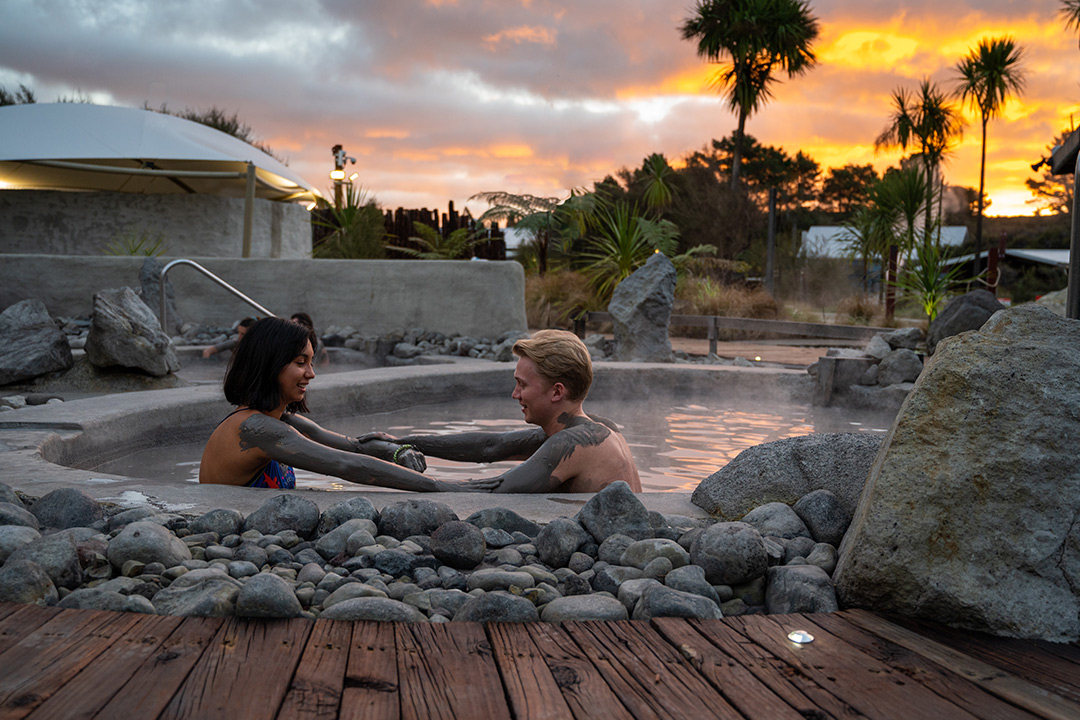
You are welcome to stroll around this living village, at no charge, to view the cooking arrangements over the boiling hot water vents and to see the outdoor bathing sheds. Alternatively, you can take a guided stroll with Kia Ora Guided Walks, who operate on-site. Towards the lake's edge is the historic and magnificently decorated St Faith’s Church, which was completed in 1914. While its exterior is Tudor-style, the church interior has a strong Māori influence, with beautiful carvings and tukutuku woven panels. A memorable feature is a stained-glass window etched with the image of Jesus wearing a Māori cloak – walking across the water of Lake Rotorua. The church is open daily or join a bilingual church service, every Sunday at 9am.
I was particularly excited to check out one of Rotorua’s newest visitor offerings, Geyser by Night – Te Puia Light Trails. Spanning 70 hectares in Te Whakarewarewa Geothermal Valley, Te Puia Thermal Reserve is a mainstay of the tourism industry, studded with mud pools, hot springs, silica formations and Pōhutu, the largest erupting geyser in the Southern Hemisphere. Te Puia boasts a variety of authentic cultural experiences throughout the day, home to a kiwi breeding programme, and the national schools of Māori wood carving, weaving, stone and bone carving. The night-time geyser encounter is a stirring new offering – fashioned for the domestic market, in the age of “doing something different.”
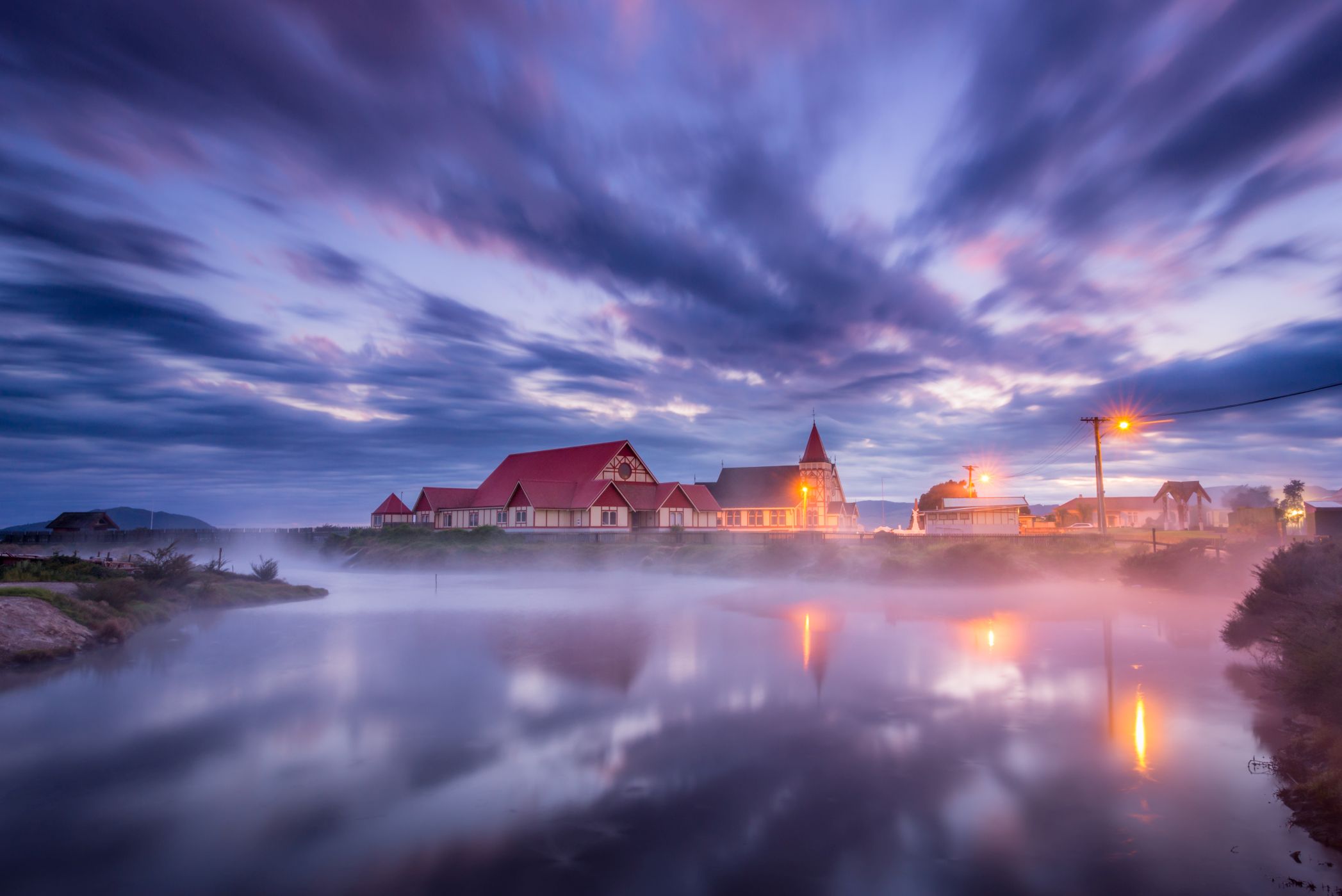
By day and by night, Pōhutu is an experience of magical proportions, erupting to a height of 30 metres, 20 times each day. But artfully illuminated for the night-time tour, it’s spell-binding sense of splendour is seriously next-level. It’s the wondrous climax to the night tour which is charismatically led by a couple of convivial Te Arawa guides, who led my group and I on a leisurely 90 minute nocturnal stroll through the thermal valley, intimately sharing historic anecdotes, tribal mythology and showcasing the valley’s remarkable features. We admired a warm lake where many centuries of warriors have bathed after battle, the sulphur cleansing their wounds. No wonder this area and its prized healing waters and constant supply of hot water was fought over so ferociously.
Local Māori have been living here for nearly 700 years, with the guides linking directing to Rotorua’s earliest hosts. At a cooking pool, our guide drew a kete from the water and we indulged in a Māori version of steamed pudding, slathered with warm custard. It was magnificent. We passed by Te Puia’s Kiwi Conservation Centre before marvelling over the site of the Waikite geyser, once the crown-jewel of the geothermal valley – with water jets shooting as high as 100 metres, before going dormant in 1969. There’s hope she may reawaken again in coming decades. It’s vast silica terrace looks wonderfully other-worldly under the night lights. We also passed by Papakura Geyser, which has shown growing signs of life after a very long hiatus. The closure of many private bores in the wider Rotorua area has undoubtedly helped restimulate geyser activity in Whakarewarewa, although they are very mercurial forces of nature. As we enjoyed a delicious hot chocolate, mighty Pōhutu started erupting.
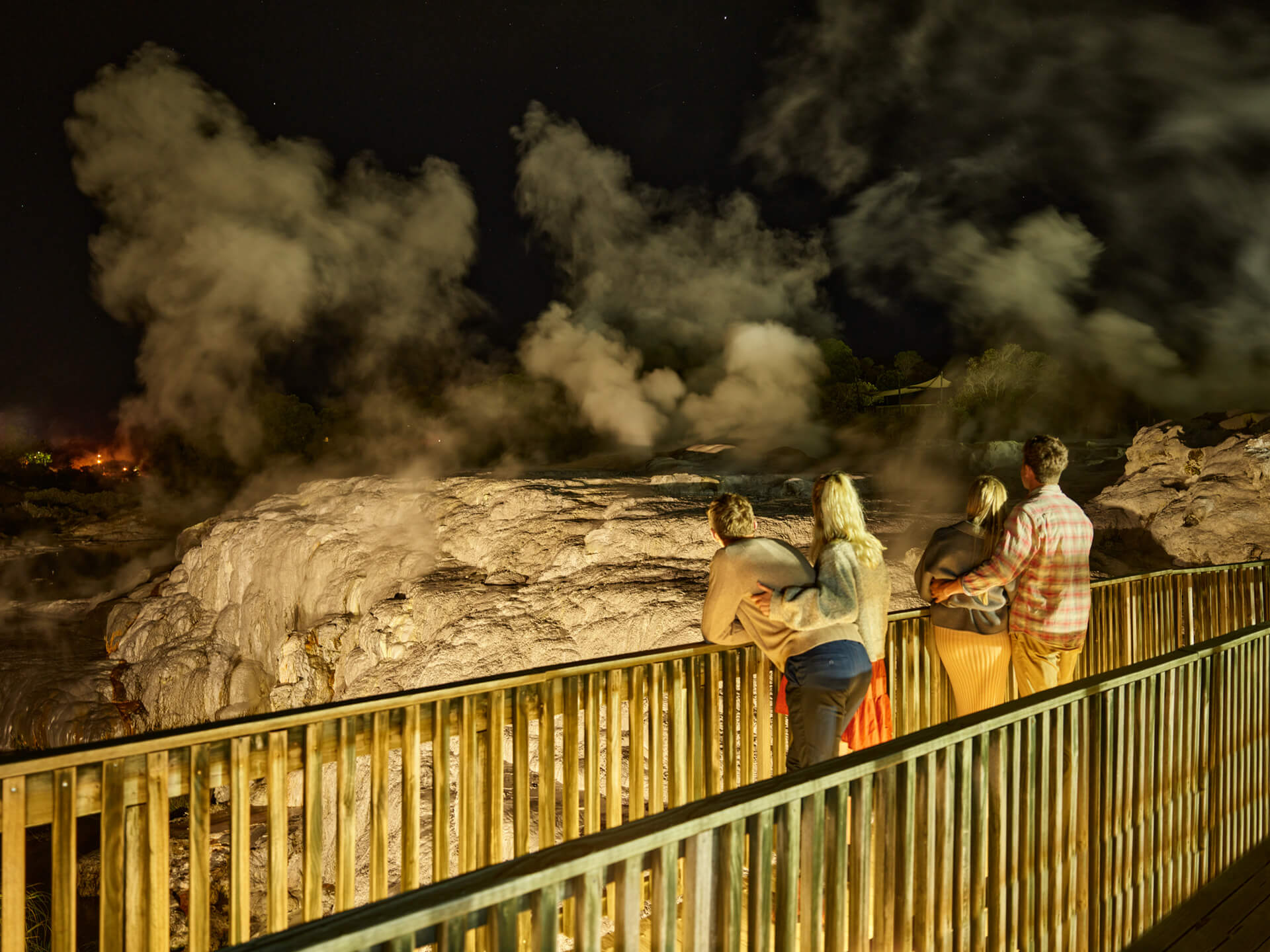
The tell-tale sign is two other geysers, Kererū and Te Tohu starting playing first. We soaked up the power and glory of the geothermal opera. The korowai of natural darkness and the evening calm heightened my senses, accentuating the sensory wonder at Te Puia. As we made our way back along those magnificent elevated boardwalks and bush pathways by torchlight, our tour wound up by Te Puia’s two intricately carved meeting houses that form part of the Rotowhio Marae. As we gazed at these flood-lit carved glories and our guides shared their insights – suddenly everything went pitch black. Spooky. Perhaps the spirits were playing with us - or the guides, although they both looked a little bemused, too! After marvelling over the magnificent 12 tall pou, that represent celestial guardians, it was time to say Haere rā, after such a radiantly engaging encounter. It’s a must-do. https://www.tepuia.com/
Craving some geothermal warmth, I headed to Hell’s Gate, just east of the city. Not only is this considered Rotorua’s most active geothermal reserve, but it’s proudly home to New Zealand’s only outdoor mud spa. For starters, I enjoyed this thermal wonderland with a guided tour around its 50 acres of erupting waters, coloured pools, hot water lakes, bubbling mud, steaming cliffs, sulphur crystals and land coral. Its sacred name is Tikitere and is considered New Zealand’s pioneering geothermal spa destination, welcoming visitors since 1867. In 1934, the celebrated Irish playwright, George Bernard Shaw, paid a visit and it blow-torched his atheist beliefs. Awestruck by the boiling mud and steam, Shaw is reported to have exclaimed “this could be the very gates of hell,” prompting local Māori to adopt Hell’s Gate as the area’s English name. He’s also credited with coining the vividly descriptive names that adorn many the pools, like Sodom & Gomorrah, Devil’s Cauldron, The Infants, Devil’s Bath and Inferno Pool.
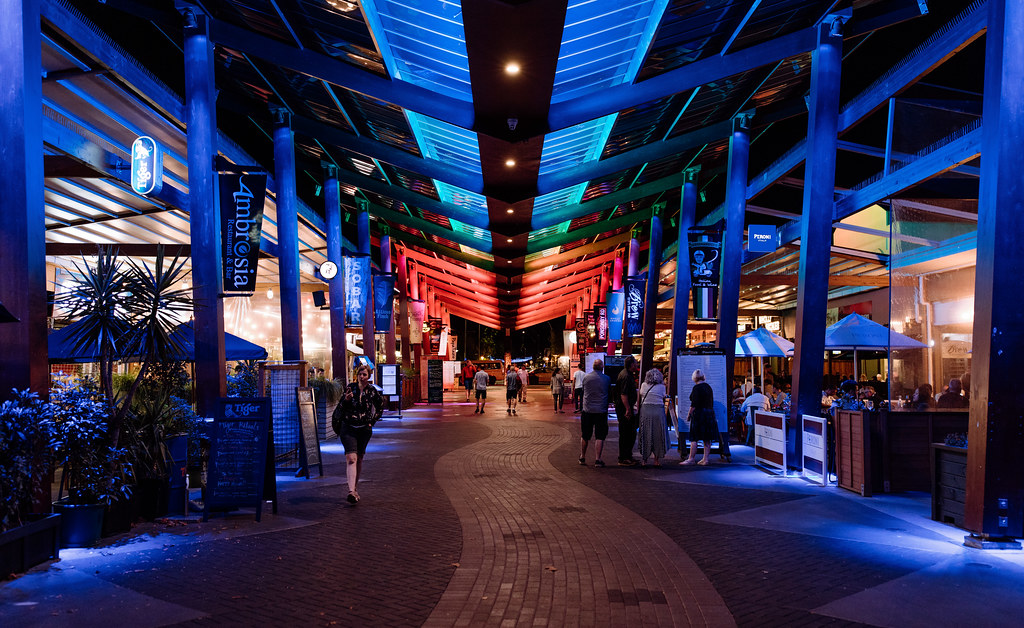
It’s a tantalising landscape as is the bush walk up to gorgeous Kakahi Falls, the largest hot waterfalls in the Southern Hemisphere, where Māori warriors once bathed themselves in the sulphuric water to remove blood and cleanse their battle wounds. Medicine Lake has also been used for up to 700 years by Māori for the treatment of many different aches and skin conditions. The lake was the inspiration for the captivating mud bath complex that operates today and is an irresistibly revitalising experience. Slathering myself liberally in warm runny mud, which dries at breath-taking speed, it’s a winning detox for the skin, sucking out impurities, exfoliating the body and relaxing sore muscles and joints. After a hot cleansing shower, I was on a very happy high, before surrendering to the sweet embrace of the hot water lagoon pool for more soothing geothermal marination. It’s a ravishing encounter. www.hellsgate.co.nz
In a city endowed with dining temptations aplenty, here’s a tried-and-true belly-pleaser to reserve some stomach room for. In the heart of Eat Street, Atticus Finch is a Mediterranean Rim alfresco restaurant with a To Kill a Mockingbird twist. I love how the outdoor courtyard is geothermally heated - how very Rotorua. The dishes are designed to be shared and the winter menu is a triumph. The fennel salt-crusted pork belly comes with parsnip puree, roasted pear, carrot & fennel salad. You also can’t go wrong with the spiced Sri Lankan fish patties with winter slaw, coconut chutney and tomato chilli sambal. If you’re heading out to The Redwoods and Whakarewarewa Forest, Eastwood is a huge crowd-pleaser, fawned over for its wood-fired pizzas, nibbles and platters for sharing. Housed within the striking Scion Research Centre, Eastwood made for a fabulous lunch stop for fungi pizza. www.rotoruanz.com
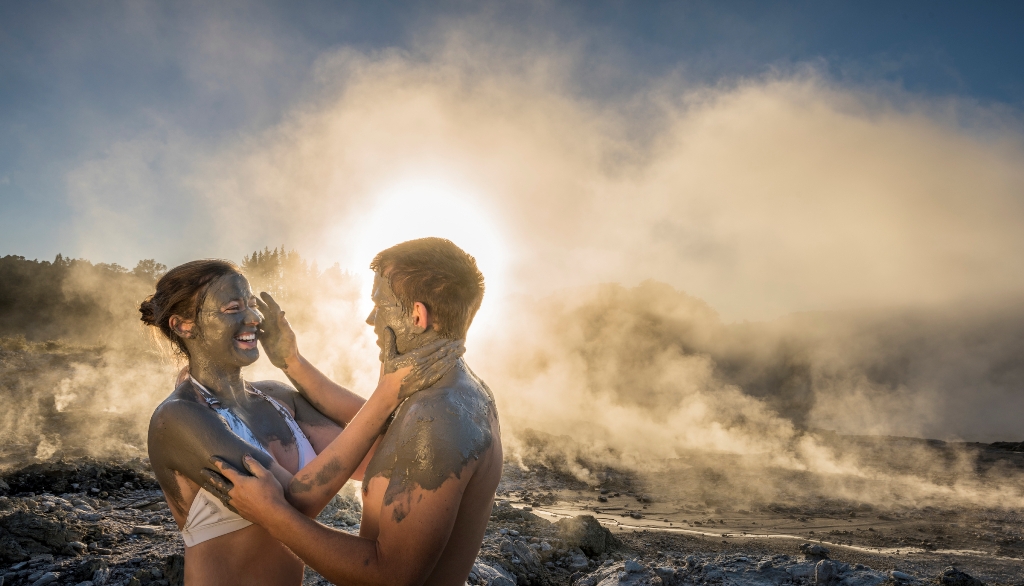
In the heart of the city, Barrel & Co. Bar and Grill is a glamourous new haunt in the Pullman Hotel, where the cuisine is anchored by hearty grill favourites and a farm-to-table philosophy. Overlooking Arawa Street, the atmosphere is convivial, with a contemporary design and an open-concept kitchen. Headed up by celebrated local chef, Isabel Ronquillo, she creates a cosmopolitan brasserie menu that showcases the best of the region’s produce through creative grill dishes, seasonal sides and divine desserts. I plumped for the divine Waitoa Chicken Breast, with corn puree, charred leeks and onion Annatto oil. I stayed at the Pullman Rotorua, which only opened about 15 months, bringing five-star frills and comforts to the city. The 130-room hotel has panoramic views across the city, effervescent bar, superbly equipped gym and that signature restaurant. It’s a Rotorua roost that pampers to sophisticated, indulgent tastes. I bagged a great rate on Booking.com. No matter what your budget or accommodation preferences may be, stake out great-value stays with complete flexibility and convenience, at https://www.booking.com
I zipped my way around Rotorua with a superb rental vehicle from Thrifty Car Rental. Offering excellent coverage across New Zealand, drive away with Thrifty’s new Risk-free Package which delivers maximum peace of mind on your journey. Priced form just $89 a day, it includes unlimited kms, zero excess, free airport fee and zero credit card fees. My pick-up and drop-off was super swift and stress-free. For full details on Thrifty’s Risk-free Package, head to https://www.thrifty.co.nz
Mike Yardley is our resident traveller on Jack Tame Saturday Mornings.
Take your Radio, Podcasts and Music with you









